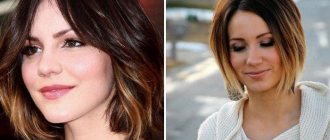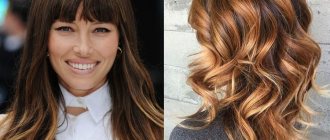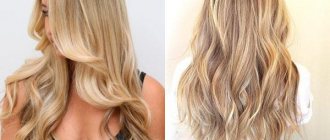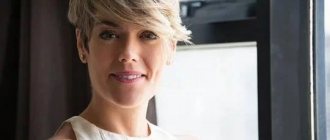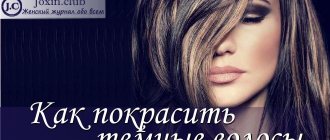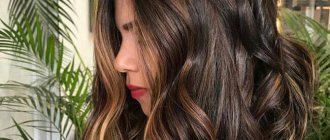Main differences
The question of the difference between these techniques worries those who cannot make a choice. They are similar in naturalness and the presence of transitions. "Shatush" has the following differences:
- Ombre looks bright. In this case, intensive lightening is performed, and the ends are the lightest. “Shatush” is a delicate method of transformation, as it refers to soft highlighting.
- With “shatush” the strands are dyed in any order, but with “ombre” the lightening should be done evenly.
- To create a “shatush”, the edge of a brush is used, so the renewal of the roots is practically invisible.
- “Shatush” is best used on short strands, and “ombre” on long strands. In this case, all the features of the techniques will be revealed.
These procedures are similar, their common features are:
- The main feature is naturalness, the use of natural colors. Classic methods involve choosing gold, honey and red tones.
- Two types of coloring are applied for approximately 4 months. No need to constantly touch up the roots. When the hair grows back, it looks natural. The roots do not change color.
- In the “shatusha” you can partially lighten the curls, as with highlighting.
Both color options are great for young girls. Thanks to them, the natural color is preserved and at the same time certain features are highlighted. The hairstyle will be much more attractive if you use this color.
Fashionable types of coloring and the secret of hair volume from Sasha Korshun- All Things Hair
Subtypes of armoring
The armoring technique is quite complex in itself, but it also has subtypes so that every girl can choose the most suitable look for herself. Despite the fact that there are a lot of videos on the Internet that describe coloring step by step, you don’t need to do it yourself.
The procedure is quite complicated, and if you make even one minor mistake, you can get a completely unpredictable result.
Let's consider what subtypes of fashionable coloring can now be found, and what features they have.
Zonal coloring
This subtype is best suited for girls who are not ready for major changes, but want to add more sunny accents to their image. This can be done by shading the strands framing the face with light colors.
Thin, literally a few hairs long, bleached curls in bangs look impressive. You can also leave the base shade on the roots, lighten the middle, and slightly darken the roots.
This technique will be more noticeable than light highlights in the hair, but it fits perfectly into delicate and discreet images.
Shatush
A rather complex technique that involves a combination of at least 3 shades. With the roots, the curls are not affected, they remain in the base color.
The middle of the strands is painted a darker color, then comes the light color, and the lightest color is at the ends.
It is very important to shade the paint well so that the transitions are minimally noticeable.
The result of the coloring will be flowing tints, the hair will be literally shrouded in sunshine, even if the weather outside is gloomy.
Ombre
A very popular and in demand technique, which is considered universal. When performing it, the emphasis is placed exclusively on the ends, creating the illusion of regrown roots. The base can be left wide or narrow, it all depends on the desired effect.
It's also good to experiment with the boundaries between dark and light shades - if you want a more subdued and natural result, you need to shade it. But to get a clear transition, shading is not required.
Ombre can be classic with dark roots and light ends, or reverse, when the roots are highlighted and the bottom is darkened.
Californian
A fashionable and very popular technique, as it involves not only creating fancy natural tints in curls, but also coloring without the use of foil or thermal paper.
The strands are left in the open air in order to make the boundaries between them as blurred as possible. In addition, there is minimal aggressive impact on the curls, since there is no thermal effect. The roots are not affected, the color is “stretched” from the dark base at the top to the light accents at the bottom.
The peculiarity of the technique is that the master uses from 2 to 5 shades that are as close to natural as possible. Their masterly combination creates the effect of curls bleached under the hot California sun.
Features of the shatush highlighting technique
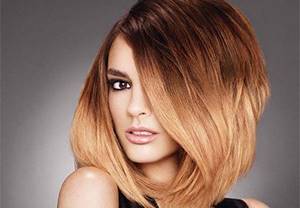
This technique is mainly used on long hair and provides a truly even and beautiful lightening background.
No additional tinting required.
The procedure is performed outdoors, does not require the use of foil and lasts no more than 40 minutes including application of the mixture.
The procedure for staining shatush occurs:
- The hair is divided into separate small strands at least 2 cm wide and fixed with clips, each strand is combed.
- Apply a lightening agent to the main, uncombed part of the hair, blending it over the surface of the hair.
- After the brightening agent has finished working, it is washed off with water and the hair is tinted with the selected shade.
As a result, the hair will be lightened unevenly, but will look natural due to the stretching of the color.
Hair coloring is an individual matter, and it is important to understand what result you want to get in the end and who you can trust to perform this procedure.
If you have figured out how to highlight shatush, then you should expect obvious showiness and fresh volume of a new hairstyle, relief and excellent movement of hair strands.
Not sure if highlighting is right for you? You didn’t know that now salons are ready to offer a dozen types of highlighting, so every girl can choose her own option. Types of hair highlighting – Californian, American, “salt and pepper” and many others.
French highlighting - what is it? You will learn about the new coloring technique in this material.
Ombre: getting to know fashion techniques better

Ombre is translated as “shadow” and, unlike shatush, has a clearer color transition boundary.
The list of actresses, singers, models and other show-girls who prefer ombre is impressive. It includes Lily Aldridge, Sandra Bullock, Jessica Alba, Miley Cyrus, Dessica Biel, Salma Hayek, Kate Beckinsale and others.
- Gives room for imagination: you can choose either a classic soft version or a more extravagant colored one.
- Visually increases hair volume.
- If your dyeing goes wrong, it is much easier to correct the situation than if you dyed your hair completely. You can simply cut off the colored ends you don't like.
- You can't do ombre if you have split ends.
- Difficult to do at home if you don't have coloring experience.
- Not every master can achieve a beautiful natural transition between shades.
- The price for coloring ranges from 2000-10000 rubles.
Varieties
The following types of ombre are distinguished:
- Classic. Characterized by natural color in the root zone and lightened tips. The difference between the shades is 1-2 tones, the transition border is soft.
- With a stripe. The hair is divided into three horizontal zones, two of which are dyed one color, and the stripe between them is dyed a contrasting color.
- Overgrown armoring. Several shades of paint close to your natural color are applied to your hair. The root zone remains untreated or is slightly darkened. Due to this, a smooth transition of colors is achieved - a soft degradation.
- The opposite. If the original hair color is dark, then the hair at the roots is lightened and the ends are left untouched. If the natural shade is light, the opposite happens: the roots are darkened, but the ends remain light.
- Monochrome. Two contrasting shades are used - light and dark. The color transition border is noticeable.
- Bright. Extravagant colors are used as accent shades - blue, green, purple, garnet, pink.
- Partial. Only some strands are dyed. This allows you to highlight your layered haircut.
- Glare. Suitable for light brown girls and blondes. A dye is applied to the hair, several shades lighter than the original color. Glare ombre gives the hairstyle a slight glow, which is why it is called highlighting.
- Tongues of flame. Used primarily for dark hair. The range of colors ranges from copper-red to red. The selection of strands for dyeing is chaotic.

What length, haircut and texture of hair is ombre suitable for?
- The ideal hair length is shoulder-length and below. If your hair is shorter, it is difficult to create a soft color transition.
- The most suitable haircuts are straight and layered (classic and elongated bob, cascade, ladder).
- The texture of hair can be either straight or wavy.
Execution technique
- The dye is applied to the selected area and covered with foil.
- After the required time for painting has passed, the paint is washed off.
- The dye is reapplied to the previously treated area, shifting the top line a couple of centimeters. Cover with foil again, wait and wash off the paint.
Shatush, balayage, ombre: differences in types of coloring
Of course, there are common features in the shades of shatush, balayage, and ombre, but there are also differences.
Shatush, balayage and ombre are united by the fact that all these types of fashionable coloring refer to color stretches. Color stretching is the transition of shades from light to dark and vice versa.
In most cases, shatush, balayage and ombre are performed by bleaching the strands and then tinting them to the desired shade. Lightening powder can be replaced with regular dye only if your hair has not been previously dyed and you do not plan to significantly change the tone of the strands.
Thus, shatush, balayage and ombre are techniques for partially lightening hair.
As a rule, the roots remain dark and the ends remain light. Credit: Rex by Shutterstock
Perhaps shatush, balayage and ombre are the most popular types of color extensions. However, there are also techniques such as sombre (softer “soft ombre”), highlighting, dip dye, and so on. But for now let's focus on the main ones.
Learn to distinguish the nuances of coloring techniques just as well as a professional colorist. Credit: Rex by Shutterstock
How does balayage differ from shatush and ombre techniques?
Balayage is a technique of light diagonal strokes.
The balayage technique helps create spectacular diagonal strokes with a smooth transition to the light ends of the hair.
The transition between shades is literally elusive. Credit: Rex by Shutterstock
Sometimes this method is called “painting” (from the English painting - “drawing”), because the master seems to actually paint on a canvas of hair.
Sometimes this is how real works of art turn out!
Balayage can be performed on dark or light hair.
Girl, can I have your colorist's phone number?
As you know, masterpieces must be looked after regularly and with special care.
Conditioner for colored hair TIGI Bed Head Color Goddess
Editor's tip: For example, use Bed Head Color Goddess Oil Infused Color Protect Shampoo and Conditioner for color-treated hair, enriched with keratin, coconut oil and sweet almond oil. Despite the content of caring oils, these products prevent rapid color fading, smooth out the hair cuticle and make it shine.
Take a closer look at the balayage technique, but don't forget about basic hair care. Credit: Rex by Shutterstock
It is worth noting that balayage is a technique that requires professionalism and painstaking work.
Balayage can be performed on hair that is approximately 7 cm long. Credit: Rex by Shutterstock
The result of dyeing in a salon is best assessed on straight hair. However, with curling, any stretch of color looks more advantageous - it’s worth taking note of this. By the way, find your favorite type of curls:
By the way, even more master classes on beautiful hairstyles can be found on the ATH YouTube channel.
Curls and balayage are perhaps one of the best combinations. Credit: Rex by Shutterstock
Which is better to choose?
Balayage is best chosen by those who do not dream of a serious change in their image, but want to add some updating and an intriguing accent to it. This method will give you the opportunity to change the color of most of the curls on your head and will noticeably change the appearance of any woman. It is best used by fair-haired and blondes - it rarely looks impressive on hair that is too dark.
Ombre is the best option for those brave ladies who have long dreamed of getting a brighter look and do not want to maintain 100% naturalness. This technique looks great on hair of any color and with a haircut of any length.
When dyeing hair using ombre technology, we must not forget that there is a high probability of deterioration in the condition of the ends of the hair, because they are greatly lightened. If you don’t have this problem with your hair, then you can seriously think about choosing this technique. In balayage, this problem disappears altogether.
For more information on the differences between coloring techniques, watch the following video.
https://glamusha.ru/beauty/1828.htmlhttps://concept-hair.ru/ombre-shatush-balayazhhttps://vplate.ru/ombre/i-balayazh/
What is shatush?
Shatush is a complex hair coloring technique that creates the effect of sun-bleached strands. It can be called a more advanced variation of California highlighting. The result of coloring with shatush is more natural and natural, without a sharp color transition
The master pays maximum attention to the strands near the face. Lightening your curls allows you to refresh your appearance and even rejuvenate it a little
Shatush can be performed on both straight and curly hair, but curled curls still look more beautiful with coloring. In this case, the hair will be visually more voluminous and textured.
You can dye both long strands and medium-length hair. Color stretching will not be possible on ultra-short hair. Coloring is possible both on layered graduated hairstyles and on strands of the same length.
This coloring technique is chosen by many Hollywood stars, such as Jessica Alba, Jennifer Aniston, Sandra Bullock. In the photo below you can see beautiful examples of dyed curls.
Execution technique
When dyeing, 2–3 shades are used, close to the natural color of the hair. The dye is gently stretched along the strands to achieve the softest color transition. The dye is applied to less than a third of all strands, the natural hair color remains the main one.
Foil is not used to dye strands, as in highlighting and coloring. The dye is applied to the strands after combing them. This allows you to achieve a more natural effect when lightening.
Coloring the shatush is performed as follows:
- the master separates a small strand about 2 centimeters thick;
- the rest of the hair is pinned up with clips so that it does not get in the way;
- the curl is combed with a thin comb;
- strands are processed in a similar manner in a chaotic manner throughout the head;
- then the paint is applied to the curls that were not included in the backcomb;
- the composition is left to act on the curls for 30 - 35 minutes and washed off.
Advantages and disadvantages
The shatush technique has a number of advantages:
- after dyeing, the hair looks voluminous and lush;
- Shatush, unlike other dyeing methods, is considered a very gentle technique for hair, since about a third of all strands are lightened;
- the effect is very natural;
- non-drastic image changes;
- The technique is suitable for any hair color, but on dark strands the coloring looks more impressive due to the contrast of shades;
- the result remains neat for 4 months;
- the roots are not dyed, so as the hair grows back there are no sudden color transitions and there is no need to repeat the procedure every month.
But the technology also has disadvantages:
- Only a professional colorist can do a beautiful job; coloring is not done at home;
- in comparison with plain coloring and highlighting, the cost of the procedure is high;
- the procedure is not performed on severely damaged split hair;
- after dyeing, the ends of the hair may become drier;
- to maintain the beauty of the shade, you will have to tint your curls in the salon or at home every one and a half to two months;
- After dyeing, to maintain the beauty of the shade, you need to choose products for caring for bleached hair.
Shatush for any look
We are all different. Some people like long curly locks or an elegant bob; many prefer a sporty style with a short haircut. Will shatush suit any hairstyle? Let’s try to figure it out.
Coloring with bangs
Perhaps the most painful issue is bangs. Whether to color it or leave it as is depends on the type of hairstyle. In short ones, lightening will definitely be present. We do things differently with long and medium hair. Coloring begins at the level of the lower edge of the bangs, the bangs themselves are not affected, or a couple of very thin strands are added.
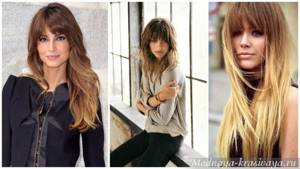
Curly hair
Shatush looks great on curly hair. You can choose this type of coloring regardless of whether you have small curls or large curls. In the first case, you will get a playful image, in the second - an amazing play of color.
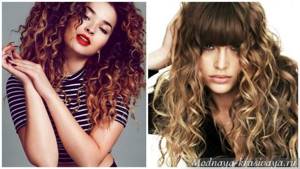
Straight hair
Owners of perfectly smooth straight hair can also easily choose this technique. But in this case, the coloring must be done flawlessly. Graduated and cascading haircuts are less demanding. The effect of multi-layering and chic volume helps out.
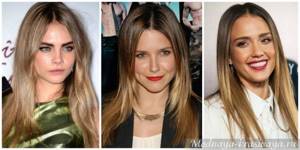
Long hair
A gift from nature or the result of one’s own efforts, long hair allows one to demonstrate the shatush in all its glory. The master’s brushes have plenty of room to flex; using one paint you can create up to five different shades, softly replacing each other.
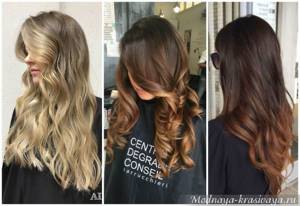
Average length
It seems that at an average length there is less room for creativity, but this is not so. Classic and asymmetrical bob, elongated bob, cascade - favorite and popular hairstyles will gain a special charm with the shatush style.

Short hair
It is unlikely that it will be possible to make such a color transition on a boy's haircut. There simply won’t be enough length, which should be present, otherwise the hairstyle will look untidy, as if the roots have just grown, and you’re too lazy to tidy yourself up. The solution is creativity. Everything changes if you use styling to create the effect of varying degrees of dishevelment.
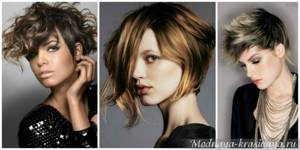
Then what's the difference?
After reading the article, you still don’t understand the difference between ombre coloring and balayage? Let's try to combine the knowledge gained into a list of the main differences between these techniques.
- Although dyeing using the ombre technique is based on the effect of faded hair, it still resembles regrown hair. If the technique is done professionally, no one will accuse you of negligence. It is certainly beautiful and attractive. Balayage, on the other hand, is designed more to create a natural appearance with strands that are slightly different from the bulk of the hair.
- Ombre involves a smooth or sharp horizontal transition from light to dark color. Balayage and shatush are, first of all, vertical coloring of individual strands.
- Balayage is difficult to perform, while ladies can do ombre on their own at home.
- The ombre technique is more suitable for girls with curly or wavy hair, while balayage is more suitable for ladies with straight curls. Ombre involves a smooth or sharp horizontal transition from light to dark color
Many girls and women are happy to experiment with hair color, because for many of us it is not just a way to express ourselves, impress a man, or transform ourselves after a long winter. This is an excellent anti-stress therapy. Successfully done coloring always lifts your mood for several weeks ahead.
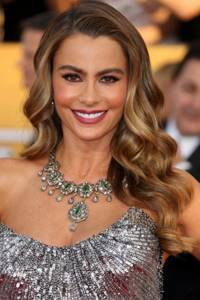
The fair half of humanity, who always pay special attention to their hair, should pay attention to the latest fashion trends. Just don’t try to blindly chase after the next Hollywood star, imitating her image
Remember, it is important for every lady to find her own style that emphasizes her individuality, sets her apart from the crowd and makes her unique
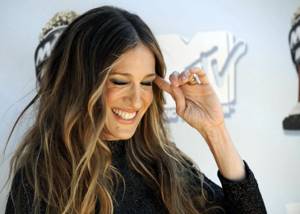
In this article, we looked at three fashion trends in hair coloring, and now you can choose between them and create your own unique look. The main advantage of these techniques is the maximum approach to naturalness.
Fashion has always dictated to us how to look today or next spring, which shades are best to use in coloring, or whether it is better to highlight or color them. Remember one thing: no matter what extremes modern stylists go to, naturalness and naturalness will always be at the peak of popularity. Fashion is so changeable, and hair health only gets worse. Strive for your natural hair color, and if you want to slightly transform your look, visit a beauty salon. A professional hairdresser will definitely advise you which technique is best to choose, select lightening shades and, with care for your hair, perform ombre or balayage dyeing.
Shatush - some strands are lightened at the ends (usually no more than half the length)
This creates smooth transitions from dark to light, which allows you to imitate the look of sunburn; special attention is paid to the front strands when doing this. Thus, this technique differs from both balayage and ombre in that only some strands are lightened instead of an all-over surface lightening
Shatush for dark long hair.
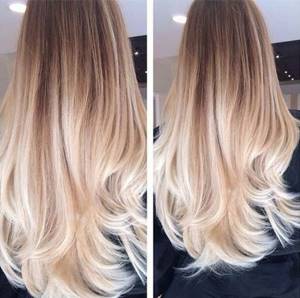
Shatush for long blond hair.
Shatush on a square.
Balayage - paint is applied to the curls in the area of the ends with superficial strokes, while the stylist seems to sweep with a brush. Strokes can be V-shaped, parallel stripes of different lengths.

Balayage for long blonde hair.
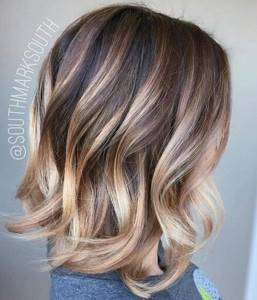
Balayage for medium length dark hair.

You can see the application technique: V-shaped strokes.
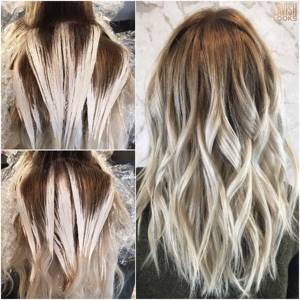
You can see the application technique: parallel stripes of different lengths.
Ombre - approximately in the middle of the hair length, a smooth transition from one color to another is created. Another name for this technique is degrade. Most often, the ends are lightened, and shades that are close to natural are selected. The roots are either left untouched or additionally darkened.
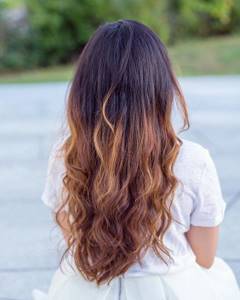
Ombre on dark hair, transition to several tones.
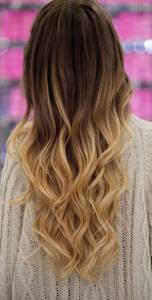
Ombre on dark hair, transition to light hair.
Bronding. Brond is a deep, voluminous color with a burnout effect. This name appeared as a result of the merger of the words brown (brown) and blond (blonde, blonde). With this painting technique, gradual transitions between two tones are created throughout the head.
On hair of different colors
It often happens that, having seen a friend or a model from a magazine cover with newfangled highlights, some ask the hairdresser to do the same for them. And then they get upset that it turned out completely different. The result depends on a number of important criteria: hair type and condition, length, color, and so on.
To understand whether shatush is right for you or not, it is advisable to look at before and after photos for your hair color and length. You can ask them from the master whom you are going to ask to perform such highlighting. This way you will protect yourself from unsuccessful coloring and the need for subsequent correction.
Dark
The richest palette is for brown-haired women. It is very beautiful to highlight dark hair with dark beige, titian, old bronze, hazelnut, milk coffee, honey and amber shades.
It should be noted that the reddishness adds a certain expressiveness to the image. Therefore, the complexion of the face must be impeccable. The listed combinations are well suited for ladies of the “autumn” color type with fair skin.
Hot brunettes can use all sorts of coffee and chocolate shades. In addition, more saturated colors suit them - for example, eggplant and ripe cherries. For ladies with hair of this color, belonging to the “winter” color type, it is advisable to prefer cool tones. Cool dark ash and platinum will decorate dark hair.
Light
For fair-haired women, “platinum blonde” and pearl shade are shown. You should not expect a pronounced effect from such coloring. But the curls will gain a healthy shine, the hairstyle will liven up and become more dynamic. You can perform shatush on light brown hair with golden, wheat and milky shades with a pearlescent tint.
This technique is simply created for blondes who want to refresh their natural color. It transforms fine hair, giving it additional volume.
If you want something more expressive, it is recommended to pay attention to California highlighting.
Blonde
Shatush for fair-haired people is usually done in shades close to the natural color. For example, dark blond strands are wonderfully shaded with ash, wheat and medium blond.
French highlighting on hair of this color allows you to achieve the ideal effect of “sun-kissed” strands. It literally breathes life into ash-blond curls that have lost their shine, filling them with inner light.
A significant visual increase in the volume and relief of the hairstyle fascinates and catches the eye. The incredible dynamics do not go unnoticed. Looks best on long hair.
Dyed and highlighted
This is where the difficulties begin. Especially if some of the hair near the roots has already grown back. If you have previously done highlighting, there is a risk of uneven coloring.
In order not to be disappointed after the procedure, it is necessary to make the overall tone of the hair even 3-4 days before the scheduled date for performing shatush. This can be achieved using a base color.
If you have recently painted with basma or henna, it is recommended to abandon French highlighting. The fact is that as a result of a chemical reaction, curls can acquire an unusually ugly color that has nothing in common with the one you expected.
Think carefully before making the final decision to make shatush. After all, several colorings in a short time is quite a serious test for hair. It will be very difficult to improve their health after this.
Balayage vs shatush
It must be said that the colors are really similar in appearance, but their main difference is that with balayage, a continuous color is created using horizontal strokes. With shatush, individual strands are lightened, using 2-3 shades that are similar in color.
Also, due to the fact that balayage leaves the natural color of the roots, it does not need to be adjusted; it is very economical and suitable for busy girls.
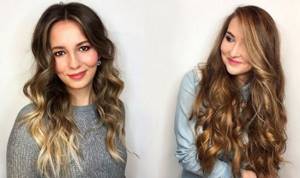
comparison table
To clearly understand all the nuances, you can take a look at this comparative table; it will briefly and clearly help you make your choice.
| Ombre | Shatush | Balayage | |
| Application | Solid | Chaotic | Chaotic |
| Transition | Smooth but crisp | Blurred | Blurred |
| Hair length | From square | Below the shoulders | Below the shoulders |
| Naturalness | No | Yes | Yes |
| Lightening zone | From the middle to the ends (emphasis on them) | From the middle | From the roots |
| Using bright colors | Maybe | No | No |
| Need for correction | No | No | Once every 2-3 months |
Each technique has its own differences and common features, look at the photos, consult with your hairdresser, pay attention to your priority criteria, then you can choose a technique to your liking, and your hairstyle will delight both you and those around you. This hair coloring technique, such as highlighting, not only does not lose its position, but also undergoes changes over time
Today, more and more often, women choose types of curl tinting such as shatush, balayage, and ombre. All 3 types have similar features. It can be difficult for the average person to see the difference between ombre and balayage. These methods of highlighting involve darkening the roots with a smooth transition and stretching of color. Like the shatush, they look stylish and natural
This hair coloring technique, such as highlighting, not only does not lose its position, but also undergoes changes over time. Today, more and more often, women choose types of curl tinting such as shatush, balayage, and ombre. All 3 types have similar features. It can be difficult for the average person to see the difference between ombre and balayage. These methods of highlighting involve darkening the roots with a smooth transition and stretching of color. Like the shatush, they look stylish and natural.
It involves tinting the strands in 2 colors with a fuzzy horizontal border. Only a professional can achieve a smooth, soft and gradual transition of shades. With ombre, it is possible to preserve the natural color of the curls in the root area.
Ombre involves painting strands from the middle to the ends. The roots and a small area adjacent to them are left untouched. Approximately from the middle, the curls begin to be dyed a tone lighter than the previous shade. As a result, the ends of the strands acquire a bright and rich color.
With balayage, approximately half of the hair is dyed a different color. The technique involves tinting the ends and strands, starting from the middle. The difference between balayage coloring is that the composition is applied in the shape of the Latin letter V. First, paint the sides of the selected strand, and then the ends. Moreover, they dye their hair all over the perimeter. Usually 2-3 shades are used, which smoothly transition into each other. The boundary can be either clear or vague.
Sometimes they are carried out only in certain areas. This technique is used especially often if the hair is short. In this case, only the strands framing the face and located at the back of the head are tinted. Using color, individual areas in asymmetrical haircuts are distinguished. The color scheme can be varied and sometimes includes very bright colors - red, red, pink, purple. The choice of shade depends on the client’s preferences.
Shatush is one of the types of gentle highlighting with stretching color transitions. The main difference is that foil and a cap are not used during the dyeing procedure. Tinting is done outdoors. Thanks to this, the negative impact of paint will be reduced to zero.
To get the desired effect, thin, closely spaced strands are processed. In this case, the master selects them in a chaotic order. The strands are dyed not along the entire length, but slightly away from the roots. In the place where the border between the colors should be, a backcomb is made.
The main feature of this technology is the uniform distribution of paint on the curls. The specialist creates soft and imperceptible color transitions. A dark shade is applied to the root zone, and a lighter shade is applied closer to the ends. If the procedure was carried out efficiently, then there should be an effect of strong shading of the paint along the entire length of the strands. According to reviews, a deep shade at the roots and a lighter shade at the ends visually gives volume to the hairstyle.
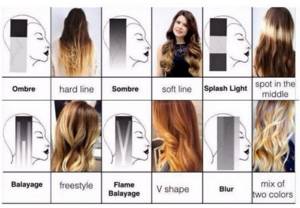
Balayage
The French invented everything beautiful, and balayage is no exception. The name of the technique speaks for itself, as translated it means “revenge.” The master seems to sweep a brush with paint over the hair, drawing an imaginary letter Ш or V. The color is applied to open hair without using foil. The color of the dye is chosen to be a tone lighter or darker than natural hair, resulting in the most natural result. Balayage is suitable for those who want to slightly refresh the image, and not completely change it.
pros
- ? With balayage, there is no need to constantly adjust the coloring.
- ? It hides gray hair perfectly.
- ? Suitable for colored and natural hair.
- ? Looks ideal on curls below the shoulders.
Minuses
Balayage cannot be done on your own, and in salons it will be expensive, since the technique is quite labor-intensive.
The difference between balayage and highlighting techniques
The balayage hair coloring technique came from France and is becoming very popular among women every year.
The peculiarity of the method is to focus on the change in color from darker to lighter. It was this coloring method that was able to perform all those tasks that other highlighting techniques could not do.

Distinctive features:
- Only a professional can dye curls, as the technique is quite complex and requires experience.
- Balayage, unlike other highlighting techniques, is suitable for absolutely all hair types.
- Balayage, unlike highlighting, involves a smooth transition of color from roots to ends.
- Highlighting should be done once every 2-3 months, but balayage will allow you to wear your hair for up to six months.
- If a girl is tired of the look, then she will have to completely repaint her highlighted strands, but balayage allows you to cut off the light ends without full coloring.
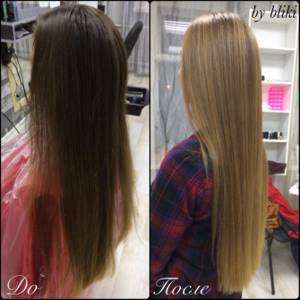
This coloring technique has no limits to the imagination, thanks to which every woman will be able to find the best option for herself without radically changing the color of her curls. The completed hairstyle will not only be attractive, but will also refresh the complexion and make the woman bright and interesting.
- about the author
- VK profile
Color stretch
Shatush is the stretching of color on small strands in a chaotic manner . The roots of the hair remain natural in color, and the transition of colors from dark to light is erased as much as possible to achieve a natural effect. Unlike other techniques, 1 shade of paint is used for coloring - darker than natural or 2-3 shades lighter.
Advantages and disadvantages
Pros:
- mild effect (does not affect the scalp and root zone, due to which it does not harm the hair structure);
- economical (does not require additional touch-up for several months);
- adds visual volume (due to color tints);
- ease of styling (just slightly curl your curls or tie a ponytail);
- An excellent option for those who want to return their natural color (will not give the appearance of simply overgrown roots).
Minuses:
- not suitable for women with dark-colored hair (pre-rinse of the dye is required);
- the high cost of the procedure in the salon;
- dries curls (due to lightening dye).
Types and what is their difference
There are two methods of dyeing using the shatush technique: classic and without backcombing . Let's look at their features and differences.
Classical
Involves backcombing for a soft line of connecting flowers.

Without backcombing
You need to braid the pigtails, apply dark paint to their length, and light paint to the ponytails, and wrap them in foil. The transition of tones will be more contrasting with this option.
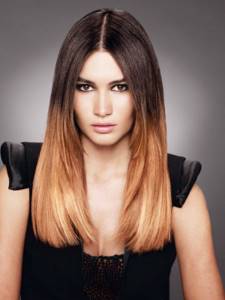
On what curls does it look spectacular?
Looks impressive on dark curly hair (chestnut, chocolate, light brown and ash brown). A haircut suitable for shatush is a bob or a cascade . It is better for fair-haired young ladies not to resort to this technique; in this case, the coloring effect will simply be invisible.
Advice! If you have more than 30% gray hair, it is better to choose another method.
Execution technique
Painting shatush involves a few simple steps:
- it is necessary to comb the curls in the root zone;
- divide the entire hair sheet into strands up to 2 cm thick;
- mix the paint in a non-metallic container;
- apply the composition using a brush with sweeping, chaotic strokes on the strands up to the backcombing area;
- maintain the time in accordance with the manufacturer’s instructions;
- rinse and dry curls.
What is the difference between ombre, bronding, balayage and shatush
Features of ombre coloring
– a term denoting gradient coloring, that is, a smooth transition of color from one shade to another
, from dark to light or vice versa. The tone of the roots is enhanced as needed, then gently moved to the ends with the help of more intense colors, their difference can be up to eight tones.
The freshest creative version of ombre plays with a clearer and sharper boundary between shades. This method, like a number of newfangled gentle techniques, uses coloring without foil, with smooth toning
, thereby achieving the effect of naturally burnt hair, it perfectly and permanently masks regrown roots.
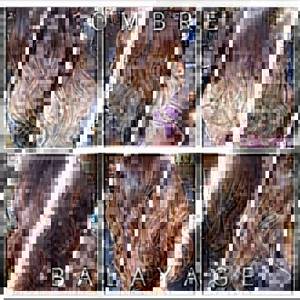
- The difference with shatush is the continuous, rather than selective, lightening of the strands.
- In contrast to the more gentle balayage, it is a superficial coloring of strands with a smooth, but clear and even boundary between tones.
- Ombre also implies a continuous change in the color of the ends, as opposed to highlighting individual strands throughout the head during bronzing.
Features of coloring shatush
Or French highlighting, also gives the hair a natural look of faded strands and achieves an even and beautiful transition of colors. The ends are chaotically lightened with an indentation from the roots
, which is smoothed by backcombing the strands. Shatush looks gorgeous on brunettes with long and medium hair.
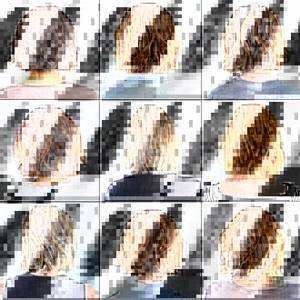
The advantages of this coloring are in many ways similar to balayage, ombre, and bronding: a tanning effect on the hair, correction of unsuccessful coloring, increased volume and texture of the hair, excellent camouflage of growing roots.
- What is the difference between shatush and balayage coloring?
And the fact is that some chaotic strands are dyed instead of their surface lightening. - Ombre also differs from shatush by the continuous application of the coloring composition, but with a deviation from the middle of the strands.
- Shatush differs from bronding with complete coloring of curls from the roots by applying paint only to the ends.
Features of balayage coloring
With the dyeing technique, from the French balayage - “revenge”, “sweep”, in which individual strands are highlighted to create a beautiful color contrast
, hair tinting is carried out by sweeping out the desired shades of paint over the base tone with horizontal strokes, only on the top layer, so the technique itself is more precise and gentle.
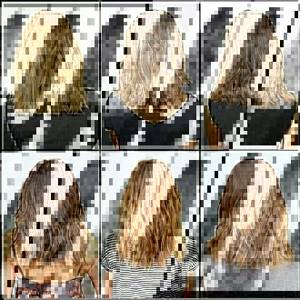
Balayage can also be used to achieve volume and light, faded highlights in the hair, as well as gentle care for growing roots. It looks as natural and relaxed as possible, but the dyeing technique itself is more complex
than others, which requires great professionalism from the master. Taking a closer look at it, it is easy to see how balayage differs from ombre and shatush.
- Unlike ombre, there is a superficial lightening of the bottom and there is no even border between tones, which is more acceptable for straight hair.
- The difference from shatush is a more continuous lightening of the strands, and not a chaotic one.
Features of bronding staining
– this is one of the latest developments by the best stylists in the field of hair coloring. With the help of booking, a neat combination of smooth transitions from dark to light shades is achieved
. This coloring technique clearly realized the dream of brunettes and brown-haired women about natural beauty, shine and well-groomed hair. Bronde perfectly shades and refreshes the skin, visualizes the thickness of the hair, looks natural with regrown roots, easily disguises gray hair with at least three lighter shades, for which caramel, honey, wheat, amber, copper or pearl tones are used.
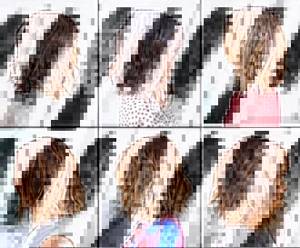
What is the difference between bronding and similar ombres
, shatush and balayage.
- Unlike ombre with a continuous change in the color of the tips, this is the lightening of individual strands throughout the head.
- Unlike shatush, curls are colored completely, starting from the roots, and not just the ends.
- Finally, unlike balayage, the dye is applied to individual strands, and not superficially, as in his case.
Ombre - what is it?
The technique is based on a smooth transition from one shade of color to another. As a rule, a blurred border is made between the darker top and the lighter bottom approximately halfway along the length. Ombre is suitable for any hair length, except for very short haircuts. Creates the effect of hair thickness.

On topic You might be interested in learning more about the ombre technique.

There are many variations of this technique:
- classic - a smooth transition from dark top to light bottom;
- reverse ombre - the opposite option to the classics: light top and dark bottom;
- shocking ombre - bright, non-standard colors are used;
- partial – using this technique to isolate individual strands of hair, etc.

This technique is ideal for light brown hair, since the main shade will not be too light or dark. In order to avoid the “pedestrian crossing” effect, the master must carefully blend the coloring compounds on the hair. A maximum of two such transitions is allowed, even if the curls are very long.
If the dyeing result is unsuccessful, it is easy to fix: either dye everything the same tone, or get a shorter haircut (cut off the ends of your hair).
You can see what exactly the master does during the ombre procedure in this video:
There are a wide variety of types of highlighting:
- Classic - comes in small, medium and large. Fine highlighting is recommended when you want to be almost blonde, to hide gray hair if the hair is poorly lightened with dye (usually done in the parietal area). Medium highlighting - done to contrast dark and light strands. It happens both vertical and horizontal. Large highlighting is done mainly to accentuate the strands. Highlighting is best tinted, because when lightened with powder, the hair remains without pigment and becomes porous, brittle and inelastic.
- Two-color highlighting - done with blonde and paint. When you want to add contrast or switch from blonde to classic highlights.
- Highlighting with a pattern - as a rule, is done for the final form of styling.
- Stencil - usually done on canvas, a specific pattern is selected. Condition: hair must be very straight when styled.
- California highlighting is a vertical coloring technique. The basis is natural or tinted hair. Strands are selected of different thicknesses and painted in tones close to the main color. The more shades the master uses, the more interesting the coloring, and accordingly, the more expensive the work.
- Coloring is multi-colored - more natural or bright shades are used. The number of shades depends on the master’s idea.
- Pearl coloring – the effect of pearl strands.
- Neon coloring – acidic, bright colors are used. It looks bold and at the same time impressive. This coloring is for modern and independent women.
- Highlighting “Salt” and “Pepper” is a play of subtle, platinum, ash, dark gray and pearl tones.
How to do balayage at home
There is nothing supernatural about balayage coloring; having some skills in coloring and lightening, you can cope with this task. But it will be difficult to dye your hair at the back yourself. Therefore, you will need the help of a second person.
For staining you need to prepare:
1. Paint of suitable shades; 2. Brush for applying the composition; 3. Mixing containers; 4. Comb with a long tail;5. Hair clips; 6. Protective gloves and negligee;7. Thin cling film, pre-cut into large rectangles (15x30).
Let's start painting, following the following sequence:
1. Prepare everything you need, dilute the paint and cover your clothes with a peignoir;2. Fix the bulk of the hair at the top, separating the “lower tier” in the temporal and occipital parts;3. Divide the hair into separate strands, their width (2 - 4 cm) will depend on the thickness of the hair; the more hair, the larger the area that is processed at a time; 4. Apply paint of a lighter tone along the edges of the selected strand, shading it with short vertical strokes, moving from bottom to top, then coat the ends thickly;5. Paint the middle with paint of an intermediate shade;6. Cover the dyed strands with film to separate them from the next row of hair to be dyed;7. In this way, gradually process the entire mass of hair.
Balayage at home video
For a smooth transition of color, providing the curls with a natural look, fair-haired young ladies are recommended to use two colors of paint, the first is 2 tones lighter than the base hair shade, and the second is four tones. The lightest one will go to the edge, and the darker one will go to the center. If the natural color is not very expressive or you need to hide gray hair, dye your hair in a tone close to your natural shade (slightly darker or lighter), and after a few days do balayage according to the above diagram.

